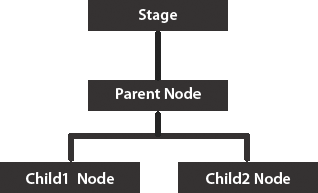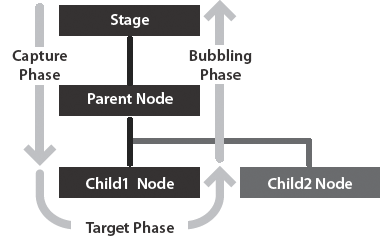The event flow
OpenFL dispatches event objects whenever an event occurs. If the event target is not on the display list, OpenFL dispatches the event object directly to the event target. For example, OpenFL dispatches the progress event object directly to a URLStream object. If the event target is on the display list, however, OpenFL dispatches the event object into the display list, and the event object travels through the display list to the event target.
The event flow describes how an event object moves through the display list. The display list is organized in a hierarchy that can be described as a tree. At the top of the display list hierarchy is the Stage, which is a special display object container that serves as the root of the display list. The Stage is represented by the openfl.display.Stage class and can only be accessed through a display object. Every display object has a property named stage that refers to the Stage for that application.
When OpenFL dispatches an event object for a display list-related event, that event object makes a round- trip journey from the Stage to the target node. The DOM Events Specification defines the target node as the node representing the event target. In other words, the target node is the display list object where the event occurred. For example, if a user clicks on a display list object named child1, OpenFL will dispatch an event object using child1 as the target node.
The event flow is conceptually divided into three parts. The first part is called the capture phase; this phase comprises all of the nodes from the Stage to the parent of the target node. The second part is called the target phase, which consists solely of the target node. The third part is called the bubbling phase. The bubbling phase comprises the nodes encountered on the return trip from the parent of the target node back to the Stage.
The names of the phases make more sense if you conceive of the display list as a vertical hierarchy with the Stage at the top, as shown in the following diagram:

If a user clicks on Child1 Node, OpenFL dispatches an event object into the event flow. As the following image shows, the object’s journey starts at Stage, moves down to Parent Node, then moves to Child1 Node, and then "bubbles" back up to Stage, moving through Parent Node again on its journey back to Stage.

In this example, the capture phase comprises Stage and Parent Node during the initial downward journey. The target phase comprises the time spent at Child1 Node. The bubbling phase comprises Parent Node and Stage as they are encountered during the upward journey back to the root node.
The ability to add event listeners along the event flow is useful when a user interface component comprises more than one object. For example, a button object often contains a text object that serves as the button’s label. Without the ability to add a listener to the event flow, you would have to add a listener to both the button object and the text object to ensure that you receive notification about click events that occur anywhere on the button. The existence of the event flow, however, allows you to place a single event listener on the button object that handles click events that occur either on the text object or on the areas of the button object that are not obscured by the text object.
Not every event object, however, participates in all three phases of the event flow. Some types of events, such as the enterFrame and init event types, are dispatched directly to the target node and participate in neither the capture phase nor the bubbling phase. Other events may target objects that are not on the display list, such as events dispatched to an instance of the Socket class. These event objects will also flow directly to the target object, without participating in the capture and bubbling phases.
To find out how a particular event type behaves, you can either check the API documentation or examine the event object’s properties. Examining the event object’s properties is described in the following section.